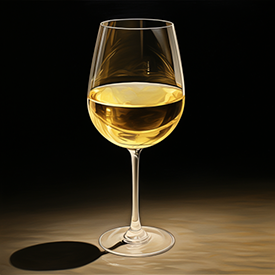The Great Wine Masquerade: Can You Unmask the Reds and Whites?
Posted by Matteo Lahm on 31st Jan 2024
Have you ever wondered if you could tell the difference between a red and a white wine if they were served at the same temperature, and you were blindfolded? It's a question that has sparked many debates in the world of wine. So, let's uncork this mystery and pour out the facts. First, let's get this straight. You're not a superhero with wine-tasting superpowers. You're a wine lover with a keen palate, and that's all you need to be. The truth is, yes, you can tell the difference between red and white wines even if they're served at the same temperature and you're blindfolded. But how, you ask? Well, it's all about the chemistry, my friends.
Red and white wines are like two different characters in a play. They might be on the same stage (your palate), but they have different scripts (flavor profiles) and costumes (tannins and acidity). The acidity profiles of red and white wines are indeed different, and this difference is not just about the overall acidity levels, but also about the specific types and quantities of acids present in each. Wine's acidity primarily comes from four types of acids: tartaric, malic, citric, and lactic. These acids are naturally found in grapes and are crucial in shaping the wine's freshness, brightness, and structure.

White wines typically have higher levels of tartaric and malic acids. This is because white grapes are usually harvested earlier than red grapes when the acid levels are higher. The elevated acidity gives white wines their characteristic crispness and zestiness. It's like a refreshing squeeze of lemon on a hot day, making your mouth water and leaving you wanting another sip.
For instance, white wines like Sauvignon Blanc and Pinot Grigio are known for their high tartaric and malic acid levels, which contribute to their vibrant, zesty citrus notes. Chardonnay, on the other hand, can range from high tartaric and malic acid levels in cooler climates (resulting in crisp green apple flavors) to lower levels in warmer regions (leading to more tropical, less acidic flavors).
White wines are like the subtle, nuanced supporting actor. They're usually made without the grape skins and seeds, which means they have fewer tannins. Instead, they rely on their acidity to create a crisp, refreshing flavor. It's like a zesty citrus note playing in the background of a symphony, adding depth and complexity to the overall performance.
Red wines, conversely, generally have slightly lower levels of tartaric and significantly lower levels of malic acids but higher levels of lactic acid due to the malolactic fermentation process that most red wines undergo. This process converts the sharper malic acid into softer lactic acid, contributing to the wine's fuller body and richer taste.

Red wines like Cabernet Sauvignon and Merlot often have a good balance of tartaric, malic, and lactic acids, giving them structure and depth. Pinot Noir, especially from cooler climates, can have higher tartaric and malic acid levels that complement its delicate fruit flavors, while maintaining a softer profile due to lactic acid.
Red wines are like the bold, dramatic lead, full of tannins that give them their characteristic astringency. These tannins come from the grape skins, seeds, and stems that are left in during the fermentation process. They're the reason why red wines have a more robust, fuller body than whites.
Let's delve into the aromatic world of wines. The bouquet of red wines often carries robust, assertive scents of dark fruits such as blackberries, plums, and cherries, complemented by undertones of spices, tobacco, and occasionally, a whisper of earthiness. In contrast, white wines usually present a more delicate, lighter aromatic profile, with hints of green apple, pear, citrus, and at times, floral nuances.
In addition to the acidity, these distinct aromas are largely influenced by terpenes, a diverse class of organic compounds produced by a variety of plants, including grapes. The terpene profiles of grapes can significantly contribute to the unique aromatic characteristics of different wines. For instance, the floral notes in some white wines can be attributed to terpenes like geraniol and linalool.
Moreover, the fermentation process, particularly the temperature at which it occurs, can also impact the wine's aroma. Lower fermentation temperatures are often used for white wines to preserve their delicate, fruity and floral aromas. On the other hand, red wines are typically fermented at higher temperatures to extract more flavors and aromas from the grape skins, resulting in their bold, complex aromatic profile.
So, the next time you take a whiff of your wine, remember that you're not just smelling the grapes, but also the terpenes and the effects of fermentation. It's a symphony of scents, all playing together to create the wine's unique aroma.
In conclusion, distinguishing between red and white wines blindfolded and at the same temperature is not a magic trick. It's a skill that comes from understanding the chemistry of wine and paying attention to the subtle cues your senses give you. So, the next time you're sipping on a glass of wine, take a moment to appreciate the complexity and craftsmanship that goes into each bottle. After all, wine is not just a beverage; it's an experience. So, even if you can't see the color of the wine, your nose can give you a pretty good clue about whether it's a red or a white. It's like having a secret decoder ring for wine. Cheers to that!

